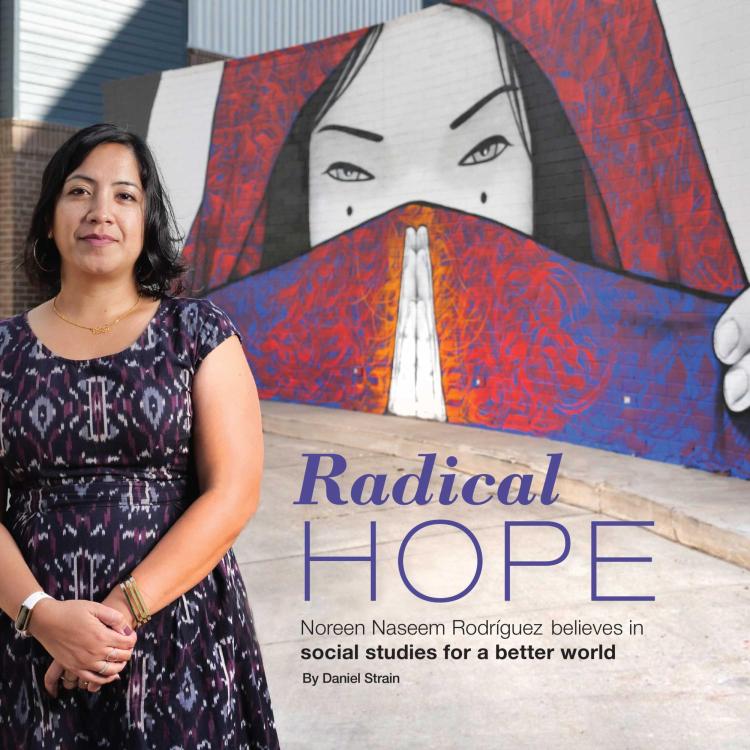Radical Hope

When Noreen Naseem Rodríguez was a fourth grade bilingual teacher in Austin, Texas, she learned the power of exploring history outside of a traditional textbook.
In 2011 and 2012, she and her students got the opportunity to take part in the Tejano History Curriculum Project—an effort to recognize Mexican Americans’ historical contributions in the Lone Star State. Together, they learned about Rosa María Hinojosa de Ballí, a woman who owned 55,000 acres in the 1700s and is sometimes called “the first cattle queen of Texas.” They also learned about Rodolfo “Corky” Gonzales, a Coloradan from Texas who helped found a movement called the Crusade for Justice in Denver.
“My white students, Mexican American students, my Black students, they were all really into learning about these histories,” she said. “We went through the index of our textbooks, and none of this stuff was in there.”
Rodríguez grew up in Texas to parents from Pakistan and the Philippines. She still remembers learning in her early 30s that Filipino sailors landed in Morro Bay, California, in 1587—a mostly untold historical event that highlights how the experiences of Asian Americans are left out of school curricula. She has dedicated her career to ensuring that young Americans can have a better experience in class than she did.
Rodríguez taught bilingual education in Texas for nine years and earned her doctorate in curriculum and instruction from the University of Texas at Austin. She’s now an assistant professor in the School of Education at CU Boulder. The author of the recent book Social Studies for a Better World, Rodríguez believes that classrooms become more vibrant, interesting and just places when children learn about a wide range of American stories—not just those of the white men in most history textbooks.
It’s a stance that touches on an increasingly contentious debate among some parents and politicians. This year, Colorado’s state school board is slated to approve a set of new social studies standards for K–12 students.
Board members, legislators, parents, educators and more have sparred over how often the standards should mention marginalized groups like people of color and the LGBTQ community. Rodríguez, however, urges educators not to shrink away from having those “difficult conversations” with their students.
“If kids are asking questions about racism or gender at school, it’s because they want to know, and they see their teacher as someone that can help them understand,” Rodríguez said. “I tell my student teachers not to shut that down.”
To foster those kinds of connections, Rodríguez has embraced what may be the most vilified three words in education today: critical race theory.
Critical race theory is a concept that emerged from law schools in the 1970s and 1980s and in its most basic sense “is a way to understand the ways in which race and racism have been deeply embedded into the laws of this country,” she said.
Rodríguez noted that many people in the U.S. misunderstand what critical race theory is actually about and that no K–12 schools in the country are teaching the concept. But in an edited book that will appear later this year called Critical Race Theory and Social Studies Futures, she and her colleagues ask the question: What if schools did teach students about how policies like redlining kept generations of Black people from owning property; how the Voting Rights Act of 1965 was critical for expanding the right to vote to all people in the country; and how, until the 1960s, decades of laws effectively banned people from Asia like Rodríguez’ family from emigrating to the U.S.
She argues that racism is woven into the lives of young people of color whether politicians acknowledge it or not. If teachers can recognize this reality, they may be able to help their students build empathy for each other. Despite the current environment for K–12 educators, Rodríguez said she’s never given up what she calls “radical hope.” As the title of her earlier book suggests, she believes that a few dedicated teachers and more expansive social studies curricula can build a better world.
“I have two kids who are in public schools, and I believe in public schools,” Rodríguez said. “I have to hope that that education has a purpose, and that by working with teachers and future teachers, my kids will have a better experience than I did.”

